Leadership Report: Evaluating Leadership Models and Impact
VerifiedAdded on 2022/12/28
|9
|2632
|42
Report
AI Summary
This report provides an in-depth analysis of leadership, exploring various leadership models and their practical applications within organizations. It begins by defining leadership and its significance, then delves into the evaluation of different leadership models such as situational, transformational, Vroom's expectancy theory, and Locke's goal setting theory, providing real-world examples to illustrate their effectiveness. The report further examines the impact of leadership on organizational culture, discussing how leaders shape culture through different approaches like role, task, power, and person cultures, using examples from companies like Facebook, Amazon, and M&S. Finally, it addresses the role of leadership in diversity management, emphasizing the importance of leaders in navigating diverse workforces and fostering inclusive environments to enhance creativity and productivity. The report concludes by summarizing the vital impact of leadership on employee performance and organizational success.
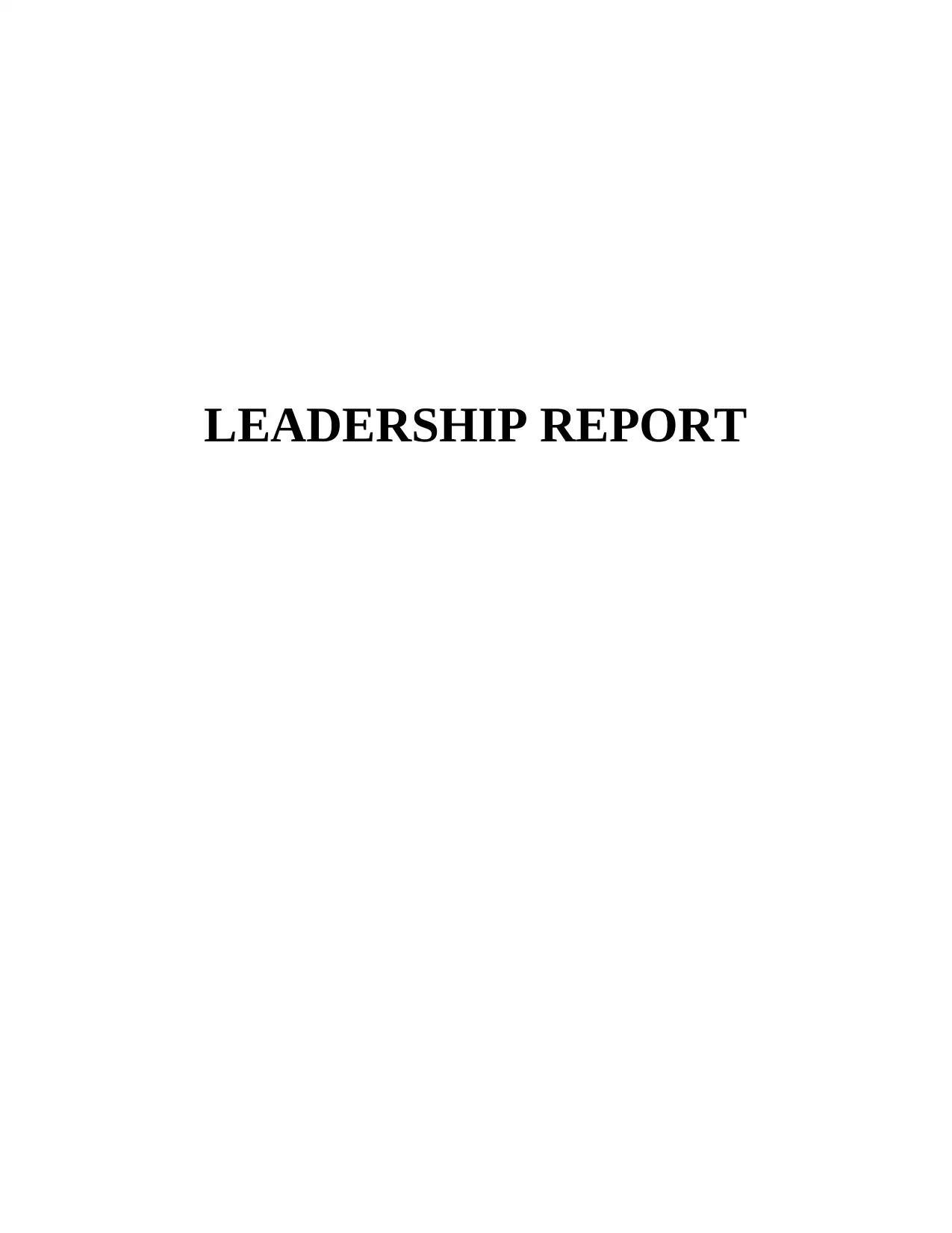
LEADERSHIP REPORT
Paraphrase This Document
Need a fresh take? Get an instant paraphrase of this document with our AI Paraphraser
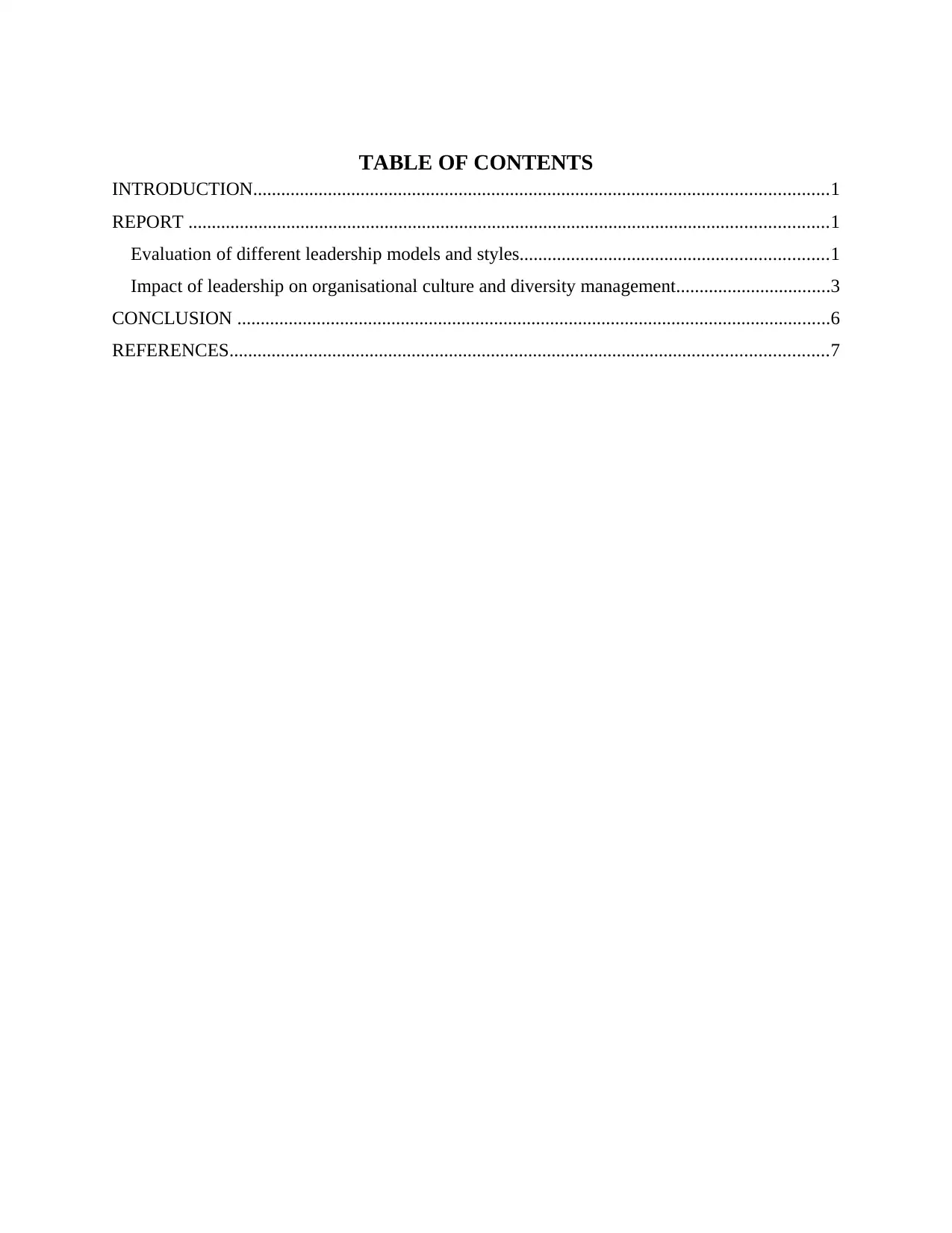
TABLE OF CONTENTS
INTRODUCTION...........................................................................................................................1
REPORT .........................................................................................................................................1
Evaluation of different leadership models and styles..................................................................1
Impact of leadership on organisational culture and diversity management.................................3
CONCLUSION ...............................................................................................................................6
REFERENCES................................................................................................................................7
INTRODUCTION...........................................................................................................................1
REPORT .........................................................................................................................................1
Evaluation of different leadership models and styles..................................................................1
Impact of leadership on organisational culture and diversity management.................................3
CONCLUSION ...............................................................................................................................6
REFERENCES................................................................................................................................7
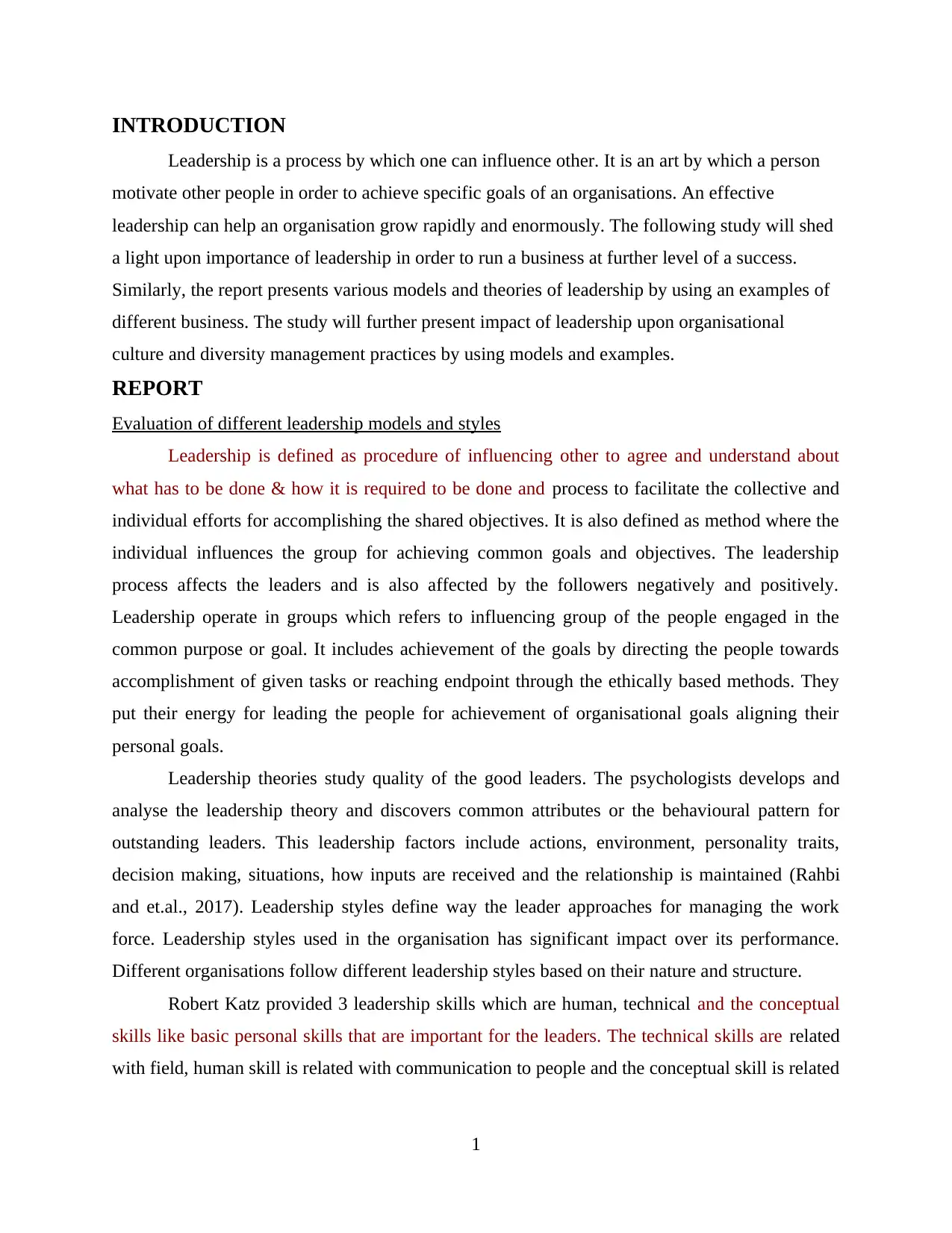
INTRODUCTION
Leadership is a process by which one can influence other. It is an art by which a person
motivate other people in order to achieve specific goals of an organisations. An effective
leadership can help an organisation grow rapidly and enormously. The following study will shed
a light upon importance of leadership in order to run a business at further level of a success.
Similarly, the report presents various models and theories of leadership by using an examples of
different business. The study will further present impact of leadership upon organisational
culture and diversity management practices by using models and examples.
REPORT
Evaluation of different leadership models and styles
Leadership is defined as procedure of influencing other to agree and understand about
what has to be done & how it is required to be done and process to facilitate the collective and
individual efforts for accomplishing the shared objectives. It is also defined as method where the
individual influences the group for achieving common goals and objectives. The leadership
process affects the leaders and is also affected by the followers negatively and positively.
Leadership operate in groups which refers to influencing group of the people engaged in the
common purpose or goal. It includes achievement of the goals by directing the people towards
accomplishment of given tasks or reaching endpoint through the ethically based methods. They
put their energy for leading the people for achievement of organisational goals aligning their
personal goals.
Leadership theories study quality of the good leaders. The psychologists develops and
analyse the leadership theory and discovers common attributes or the behavioural pattern for
outstanding leaders. This leadership factors include actions, environment, personality traits,
decision making, situations, how inputs are received and the relationship is maintained (Rahbi
and et.al., 2017). Leadership styles define way the leader approaches for managing the work
force. Leadership styles used in the organisation has significant impact over its performance.
Different organisations follow different leadership styles based on their nature and structure.
Robert Katz provided 3 leadership skills which are human, technical and the conceptual
skills like basic personal skills that are important for the leaders. The technical skills are related
with field, human skill is related with communication to people and the conceptual skill is related
1
Leadership is a process by which one can influence other. It is an art by which a person
motivate other people in order to achieve specific goals of an organisations. An effective
leadership can help an organisation grow rapidly and enormously. The following study will shed
a light upon importance of leadership in order to run a business at further level of a success.
Similarly, the report presents various models and theories of leadership by using an examples of
different business. The study will further present impact of leadership upon organisational
culture and diversity management practices by using models and examples.
REPORT
Evaluation of different leadership models and styles
Leadership is defined as procedure of influencing other to agree and understand about
what has to be done & how it is required to be done and process to facilitate the collective and
individual efforts for accomplishing the shared objectives. It is also defined as method where the
individual influences the group for achieving common goals and objectives. The leadership
process affects the leaders and is also affected by the followers negatively and positively.
Leadership operate in groups which refers to influencing group of the people engaged in the
common purpose or goal. It includes achievement of the goals by directing the people towards
accomplishment of given tasks or reaching endpoint through the ethically based methods. They
put their energy for leading the people for achievement of organisational goals aligning their
personal goals.
Leadership theories study quality of the good leaders. The psychologists develops and
analyse the leadership theory and discovers common attributes or the behavioural pattern for
outstanding leaders. This leadership factors include actions, environment, personality traits,
decision making, situations, how inputs are received and the relationship is maintained (Rahbi
and et.al., 2017). Leadership styles define way the leader approaches for managing the work
force. Leadership styles used in the organisation has significant impact over its performance.
Different organisations follow different leadership styles based on their nature and structure.
Robert Katz provided 3 leadership skills which are human, technical and the conceptual
skills like basic personal skills that are important for the leaders. The technical skills are related
with field, human skill is related with communication to people and the conceptual skill is related
1
⊘ This is a preview!⊘
Do you want full access?
Subscribe today to unlock all pages.

Trusted by 1+ million students worldwide
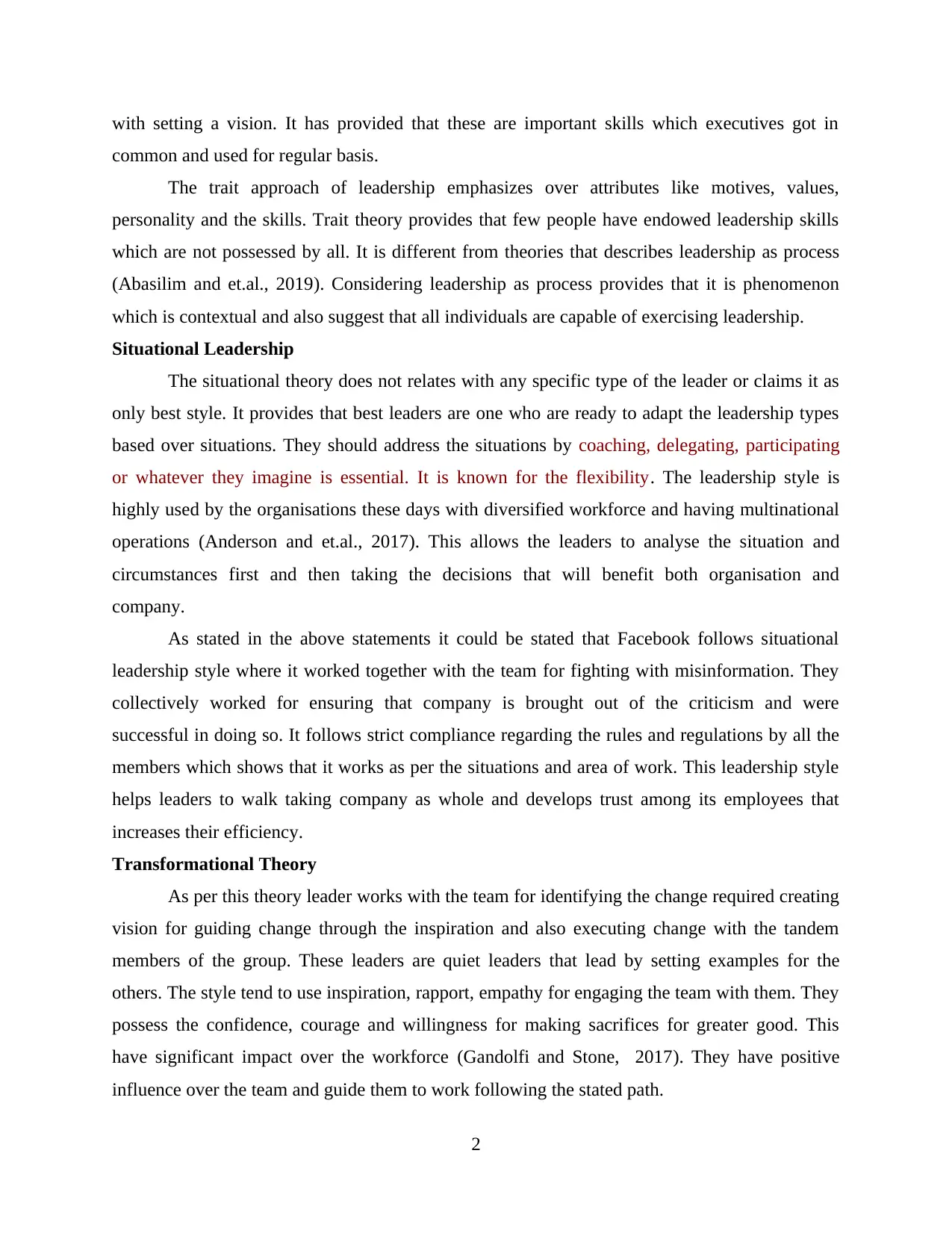
with setting a vision. It has provided that these are important skills which executives got in
common and used for regular basis.
The trait approach of leadership emphasizes over attributes like motives, values,
personality and the skills. Trait theory provides that few people have endowed leadership skills
which are not possessed by all. It is different from theories that describes leadership as process
(Abasilim and et.al., 2019). Considering leadership as process provides that it is phenomenon
which is contextual and also suggest that all individuals are capable of exercising leadership.
Situational Leadership
The situational theory does not relates with any specific type of the leader or claims it as
only best style. It provides that best leaders are one who are ready to adapt the leadership types
based over situations. They should address the situations by coaching, delegating, participating
or whatever they imagine is essential. It is known for the flexibility. The leadership style is
highly used by the organisations these days with diversified workforce and having multinational
operations (Anderson and et.al., 2017). This allows the leaders to analyse the situation and
circumstances first and then taking the decisions that will benefit both organisation and
company.
As stated in the above statements it could be stated that Facebook follows situational
leadership style where it worked together with the team for fighting with misinformation. They
collectively worked for ensuring that company is brought out of the criticism and were
successful in doing so. It follows strict compliance regarding the rules and regulations by all the
members which shows that it works as per the situations and area of work. This leadership style
helps leaders to walk taking company as whole and develops trust among its employees that
increases their efficiency.
Transformational Theory
As per this theory leader works with the team for identifying the change required creating
vision for guiding change through the inspiration and also executing change with the tandem
members of the group. These leaders are quiet leaders that lead by setting examples for the
others. The style tend to use inspiration, rapport, empathy for engaging the team with them. They
possess the confidence, courage and willingness for making sacrifices for greater good. This
have significant impact over the workforce (Gandolfi and Stone, 2017). They have positive
influence over the team and guide them to work following the stated path.
2
common and used for regular basis.
The trait approach of leadership emphasizes over attributes like motives, values,
personality and the skills. Trait theory provides that few people have endowed leadership skills
which are not possessed by all. It is different from theories that describes leadership as process
(Abasilim and et.al., 2019). Considering leadership as process provides that it is phenomenon
which is contextual and also suggest that all individuals are capable of exercising leadership.
Situational Leadership
The situational theory does not relates with any specific type of the leader or claims it as
only best style. It provides that best leaders are one who are ready to adapt the leadership types
based over situations. They should address the situations by coaching, delegating, participating
or whatever they imagine is essential. It is known for the flexibility. The leadership style is
highly used by the organisations these days with diversified workforce and having multinational
operations (Anderson and et.al., 2017). This allows the leaders to analyse the situation and
circumstances first and then taking the decisions that will benefit both organisation and
company.
As stated in the above statements it could be stated that Facebook follows situational
leadership style where it worked together with the team for fighting with misinformation. They
collectively worked for ensuring that company is brought out of the criticism and were
successful in doing so. It follows strict compliance regarding the rules and regulations by all the
members which shows that it works as per the situations and area of work. This leadership style
helps leaders to walk taking company as whole and develops trust among its employees that
increases their efficiency.
Transformational Theory
As per this theory leader works with the team for identifying the change required creating
vision for guiding change through the inspiration and also executing change with the tandem
members of the group. These leaders are quiet leaders that lead by setting examples for the
others. The style tend to use inspiration, rapport, empathy for engaging the team with them. They
possess the confidence, courage and willingness for making sacrifices for greater good. This
have significant impact over the workforce (Gandolfi and Stone, 2017). They have positive
influence over the team and guide them to work following the stated path.
2
Paraphrase This Document
Need a fresh take? Get an instant paraphrase of this document with our AI Paraphraser
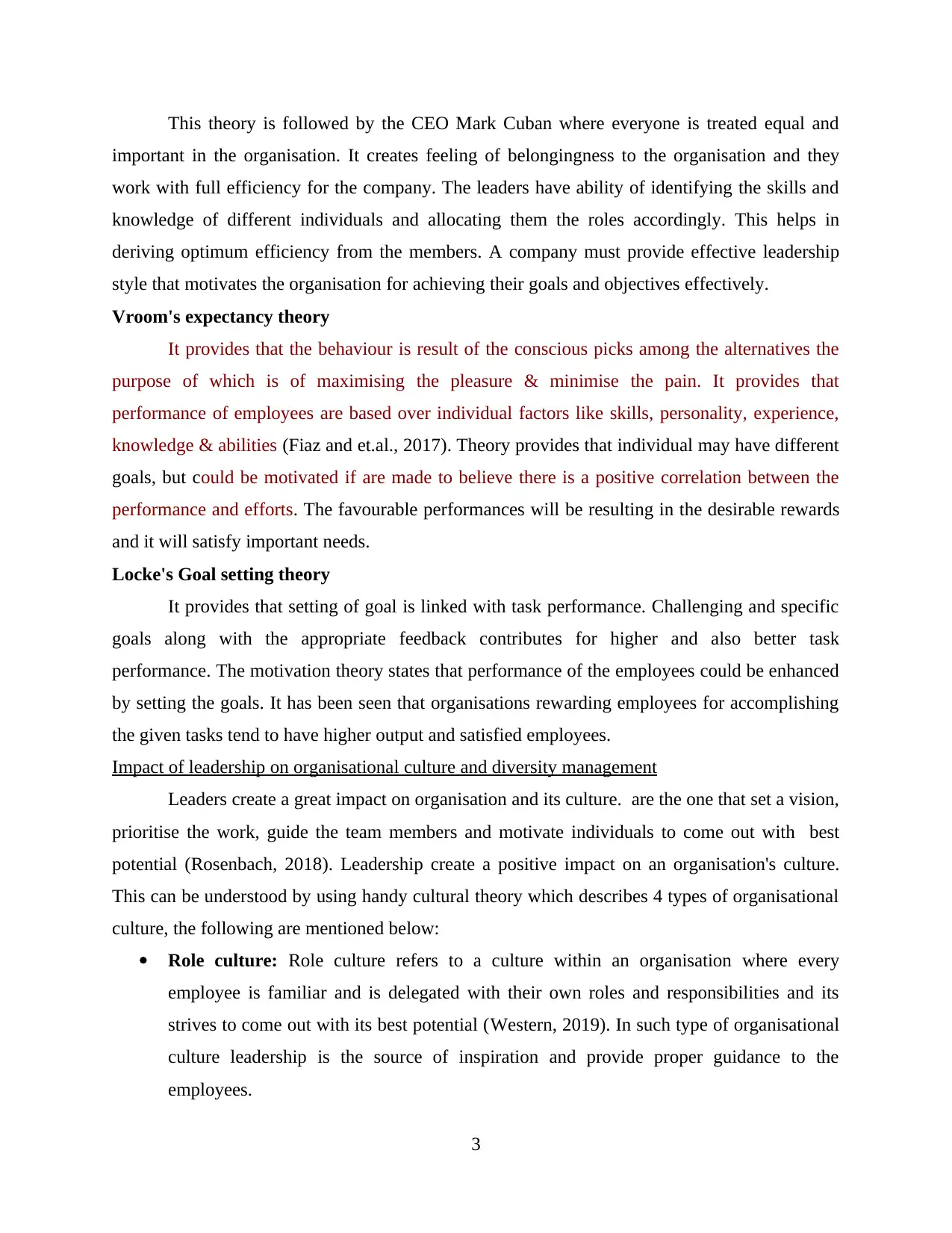
This theory is followed by the CEO Mark Cuban where everyone is treated equal and
important in the organisation. It creates feeling of belongingness to the organisation and they
work with full efficiency for the company. The leaders have ability of identifying the skills and
knowledge of different individuals and allocating them the roles accordingly. This helps in
deriving optimum efficiency from the members. A company must provide effective leadership
style that motivates the organisation for achieving their goals and objectives effectively.
Vroom's expectancy theory
It provides that the behaviour is result of the conscious picks among the alternatives the
purpose of which is of maximising the pleasure & minimise the pain. It provides that
performance of employees are based over individual factors like skills, personality, experience,
knowledge & abilities (Fiaz and et.al., 2017). Theory provides that individual may have different
goals, but could be motivated if are made to believe there is a positive correlation between the
performance and efforts. The favourable performances will be resulting in the desirable rewards
and it will satisfy important needs.
Locke's Goal setting theory
It provides that setting of goal is linked with task performance. Challenging and specific
goals along with the appropriate feedback contributes for higher and also better task
performance. The motivation theory states that performance of the employees could be enhanced
by setting the goals. It has been seen that organisations rewarding employees for accomplishing
the given tasks tend to have higher output and satisfied employees.
Impact of leadership on organisational culture and diversity management
Leaders create a great impact on organisation and its culture. are the one that set a vision,
prioritise the work, guide the team members and motivate individuals to come out with best
potential (Rosenbach, 2018). Leadership create a positive impact on an organisation's culture.
This can be understood by using handy cultural theory which describes 4 types of organisational
culture, the following are mentioned below:
Role culture: Role culture refers to a culture within an organisation where every
employee is familiar and is delegated with their own roles and responsibilities and its
strives to come out with its best potential (Western, 2019). In such type of organisational
culture leadership is the source of inspiration and provide proper guidance to the
employees.
3
important in the organisation. It creates feeling of belongingness to the organisation and they
work with full efficiency for the company. The leaders have ability of identifying the skills and
knowledge of different individuals and allocating them the roles accordingly. This helps in
deriving optimum efficiency from the members. A company must provide effective leadership
style that motivates the organisation for achieving their goals and objectives effectively.
Vroom's expectancy theory
It provides that the behaviour is result of the conscious picks among the alternatives the
purpose of which is of maximising the pleasure & minimise the pain. It provides that
performance of employees are based over individual factors like skills, personality, experience,
knowledge & abilities (Fiaz and et.al., 2017). Theory provides that individual may have different
goals, but could be motivated if are made to believe there is a positive correlation between the
performance and efforts. The favourable performances will be resulting in the desirable rewards
and it will satisfy important needs.
Locke's Goal setting theory
It provides that setting of goal is linked with task performance. Challenging and specific
goals along with the appropriate feedback contributes for higher and also better task
performance. The motivation theory states that performance of the employees could be enhanced
by setting the goals. It has been seen that organisations rewarding employees for accomplishing
the given tasks tend to have higher output and satisfied employees.
Impact of leadership on organisational culture and diversity management
Leaders create a great impact on organisation and its culture. are the one that set a vision,
prioritise the work, guide the team members and motivate individuals to come out with best
potential (Rosenbach, 2018). Leadership create a positive impact on an organisation's culture.
This can be understood by using handy cultural theory which describes 4 types of organisational
culture, the following are mentioned below:
Role culture: Role culture refers to a culture within an organisation where every
employee is familiar and is delegated with their own roles and responsibilities and its
strives to come out with its best potential (Western, 2019). In such type of organisational
culture leadership is the source of inspiration and provide proper guidance to the
employees.
3
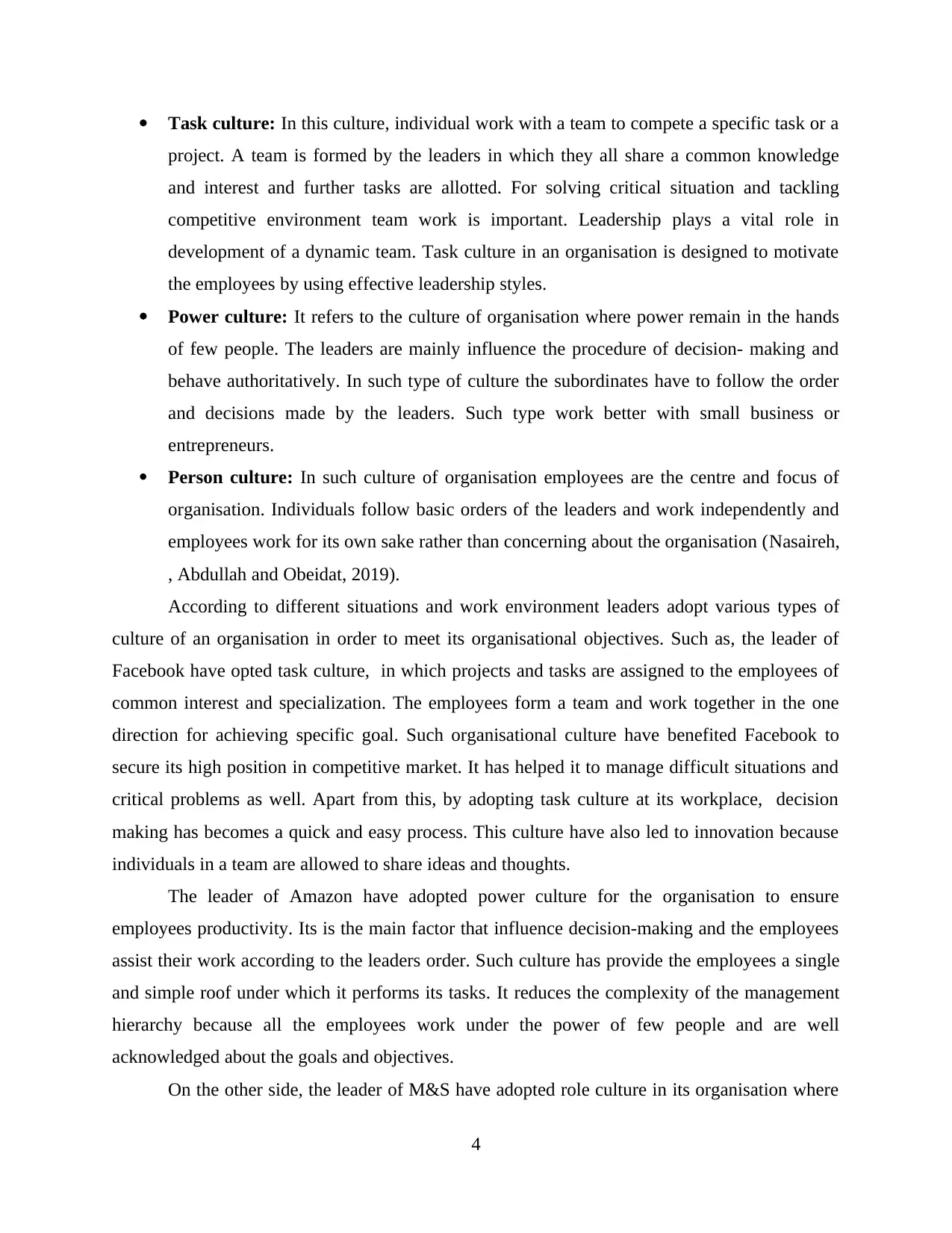
Task culture: In this culture, individual work with a team to compete a specific task or a
project. A team is formed by the leaders in which they all share a common knowledge
and interest and further tasks are allotted. For solving critical situation and tackling
competitive environment team work is important. Leadership plays a vital role in
development of a dynamic team. Task culture in an organisation is designed to motivate
the employees by using effective leadership styles.
Power culture: It refers to the culture of organisation where power remain in the hands
of few people. The leaders are mainly influence the procedure of decision- making and
behave authoritatively. In such type of culture the subordinates have to follow the order
and decisions made by the leaders. Such type work better with small business or
entrepreneurs.
Person culture: In such culture of organisation employees are the centre and focus of
organisation. Individuals follow basic orders of the leaders and work independently and
employees work for its own sake rather than concerning about the organisation (Nasaireh,
, Abdullah and Obeidat, 2019).
According to different situations and work environment leaders adopt various types of
culture of an organisation in order to meet its organisational objectives. Such as, the leader of
Facebook have opted task culture, in which projects and tasks are assigned to the employees of
common interest and specialization. The employees form a team and work together in the one
direction for achieving specific goal. Such organisational culture have benefited Facebook to
secure its high position in competitive market. It has helped it to manage difficult situations and
critical problems as well. Apart from this, by adopting task culture at its workplace, decision
making has becomes a quick and easy process. This culture have also led to innovation because
individuals in a team are allowed to share ideas and thoughts.
The leader of Amazon have adopted power culture for the organisation to ensure
employees productivity. Its is the main factor that influence decision-making and the employees
assist their work according to the leaders order. Such culture has provide the employees a single
and simple roof under which it performs its tasks. It reduces the complexity of the management
hierarchy because all the employees work under the power of few people and are well
acknowledged about the goals and objectives.
On the other side, the leader of M&S have adopted role culture in its organisation where
4
project. A team is formed by the leaders in which they all share a common knowledge
and interest and further tasks are allotted. For solving critical situation and tackling
competitive environment team work is important. Leadership plays a vital role in
development of a dynamic team. Task culture in an organisation is designed to motivate
the employees by using effective leadership styles.
Power culture: It refers to the culture of organisation where power remain in the hands
of few people. The leaders are mainly influence the procedure of decision- making and
behave authoritatively. In such type of culture the subordinates have to follow the order
and decisions made by the leaders. Such type work better with small business or
entrepreneurs.
Person culture: In such culture of organisation employees are the centre and focus of
organisation. Individuals follow basic orders of the leaders and work independently and
employees work for its own sake rather than concerning about the organisation (Nasaireh,
, Abdullah and Obeidat, 2019).
According to different situations and work environment leaders adopt various types of
culture of an organisation in order to meet its organisational objectives. Such as, the leader of
Facebook have opted task culture, in which projects and tasks are assigned to the employees of
common interest and specialization. The employees form a team and work together in the one
direction for achieving specific goal. Such organisational culture have benefited Facebook to
secure its high position in competitive market. It has helped it to manage difficult situations and
critical problems as well. Apart from this, by adopting task culture at its workplace, decision
making has becomes a quick and easy process. This culture have also led to innovation because
individuals in a team are allowed to share ideas and thoughts.
The leader of Amazon have adopted power culture for the organisation to ensure
employees productivity. Its is the main factor that influence decision-making and the employees
assist their work according to the leaders order. Such culture has provide the employees a single
and simple roof under which it performs its tasks. It reduces the complexity of the management
hierarchy because all the employees work under the power of few people and are well
acknowledged about the goals and objectives.
On the other side, the leader of M&S have adopted role culture in its organisation where
4
⊘ This is a preview!⊘
Do you want full access?
Subscribe today to unlock all pages.

Trusted by 1+ million students worldwide
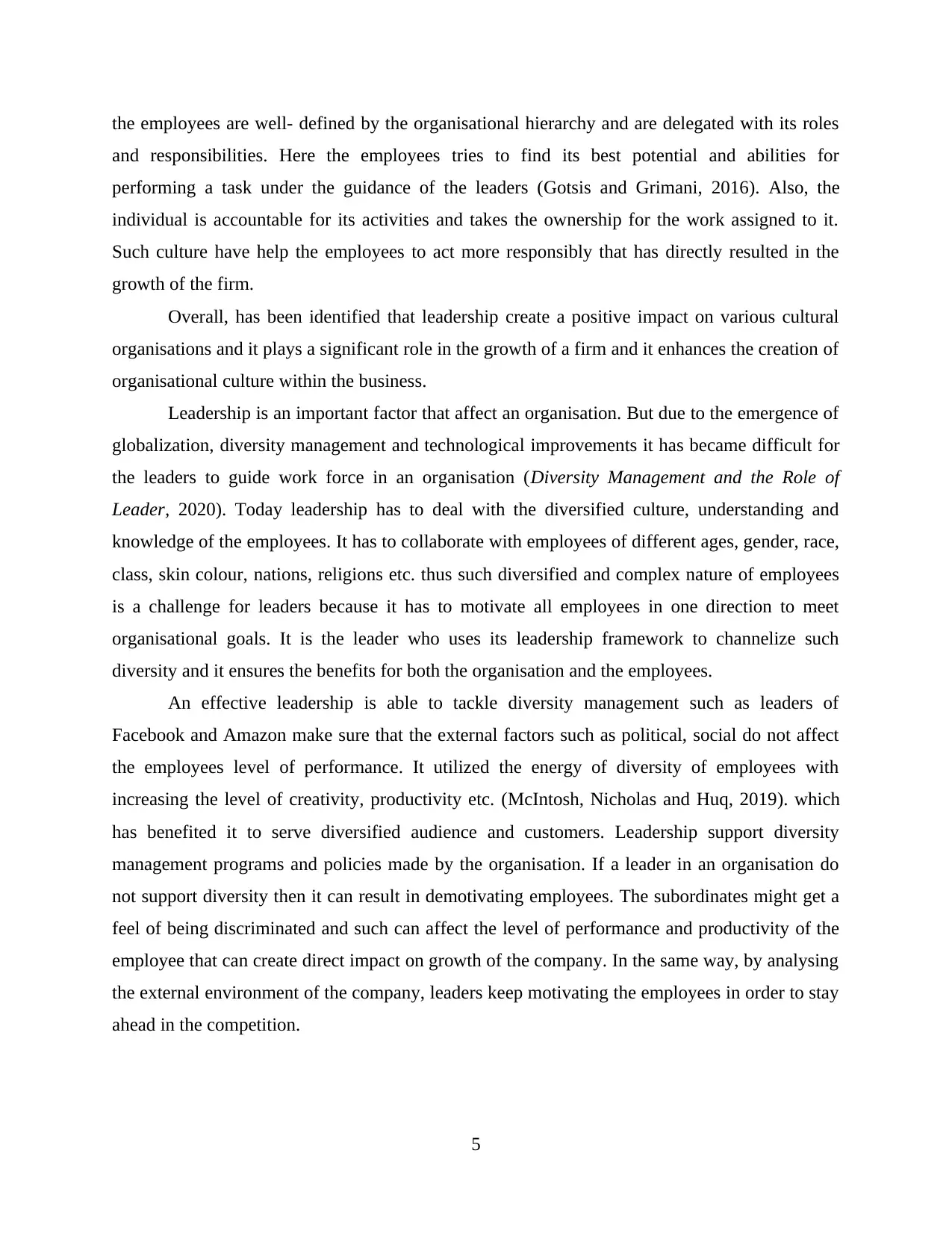
the employees are well- defined by the organisational hierarchy and are delegated with its roles
and responsibilities. Here the employees tries to find its best potential and abilities for
performing a task under the guidance of the leaders (Gotsis and Grimani, 2016). Also, the
individual is accountable for its activities and takes the ownership for the work assigned to it.
Such culture have help the employees to act more responsibly that has directly resulted in the
growth of the firm.
Overall, has been identified that leadership create a positive impact on various cultural
organisations and it plays a significant role in the growth of a firm and it enhances the creation of
organisational culture within the business.
Leadership is an important factor that affect an organisation. But due to the emergence of
globalization, diversity management and technological improvements it has became difficult for
the leaders to guide work force in an organisation (Diversity Management and the Role of
Leader, 2020). Today leadership has to deal with the diversified culture, understanding and
knowledge of the employees. It has to collaborate with employees of different ages, gender, race,
class, skin colour, nations, religions etc. thus such diversified and complex nature of employees
is a challenge for leaders because it has to motivate all employees in one direction to meet
organisational goals. It is the leader who uses its leadership framework to channelize such
diversity and it ensures the benefits for both the organisation and the employees.
An effective leadership is able to tackle diversity management such as leaders of
Facebook and Amazon make sure that the external factors such as political, social do not affect
the employees level of performance. It utilized the energy of diversity of employees with
increasing the level of creativity, productivity etc. (McIntosh, Nicholas and Huq, 2019). which
has benefited it to serve diversified audience and customers. Leadership support diversity
management programs and policies made by the organisation. If a leader in an organisation do
not support diversity then it can result in demotivating employees. The subordinates might get a
feel of being discriminated and such can affect the level of performance and productivity of the
employee that can create direct impact on growth of the company. In the same way, by analysing
the external environment of the company, leaders keep motivating the employees in order to stay
ahead in the competition.
5
and responsibilities. Here the employees tries to find its best potential and abilities for
performing a task under the guidance of the leaders (Gotsis and Grimani, 2016). Also, the
individual is accountable for its activities and takes the ownership for the work assigned to it.
Such culture have help the employees to act more responsibly that has directly resulted in the
growth of the firm.
Overall, has been identified that leadership create a positive impact on various cultural
organisations and it plays a significant role in the growth of a firm and it enhances the creation of
organisational culture within the business.
Leadership is an important factor that affect an organisation. But due to the emergence of
globalization, diversity management and technological improvements it has became difficult for
the leaders to guide work force in an organisation (Diversity Management and the Role of
Leader, 2020). Today leadership has to deal with the diversified culture, understanding and
knowledge of the employees. It has to collaborate with employees of different ages, gender, race,
class, skin colour, nations, religions etc. thus such diversified and complex nature of employees
is a challenge for leaders because it has to motivate all employees in one direction to meet
organisational goals. It is the leader who uses its leadership framework to channelize such
diversity and it ensures the benefits for both the organisation and the employees.
An effective leadership is able to tackle diversity management such as leaders of
Facebook and Amazon make sure that the external factors such as political, social do not affect
the employees level of performance. It utilized the energy of diversity of employees with
increasing the level of creativity, productivity etc. (McIntosh, Nicholas and Huq, 2019). which
has benefited it to serve diversified audience and customers. Leadership support diversity
management programs and policies made by the organisation. If a leader in an organisation do
not support diversity then it can result in demotivating employees. The subordinates might get a
feel of being discriminated and such can affect the level of performance and productivity of the
employee that can create direct impact on growth of the company. In the same way, by analysing
the external environment of the company, leaders keep motivating the employees in order to stay
ahead in the competition.
5
Paraphrase This Document
Need a fresh take? Get an instant paraphrase of this document with our AI Paraphraser
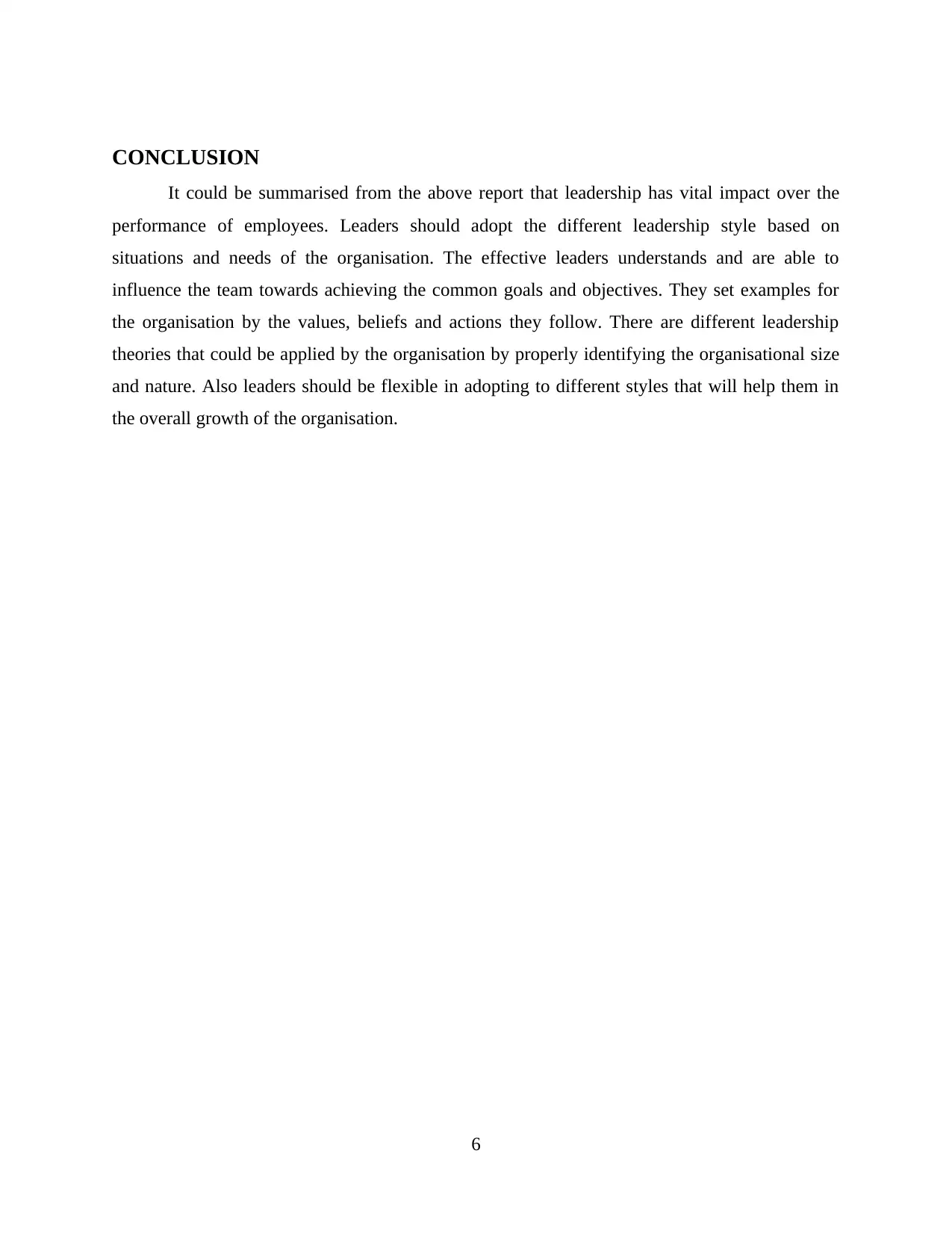
CONCLUSION
It could be summarised from the above report that leadership has vital impact over the
performance of employees. Leaders should adopt the different leadership style based on
situations and needs of the organisation. The effective leaders understands and are able to
influence the team towards achieving the common goals and objectives. They set examples for
the organisation by the values, beliefs and actions they follow. There are different leadership
theories that could be applied by the organisation by properly identifying the organisational size
and nature. Also leaders should be flexible in adopting to different styles that will help them in
the overall growth of the organisation.
6
It could be summarised from the above report that leadership has vital impact over the
performance of employees. Leaders should adopt the different leadership style based on
situations and needs of the organisation. The effective leaders understands and are able to
influence the team towards achieving the common goals and objectives. They set examples for
the organisation by the values, beliefs and actions they follow. There are different leadership
theories that could be applied by the organisation by properly identifying the organisational size
and nature. Also leaders should be flexible in adopting to different styles that will help them in
the overall growth of the organisation.
6
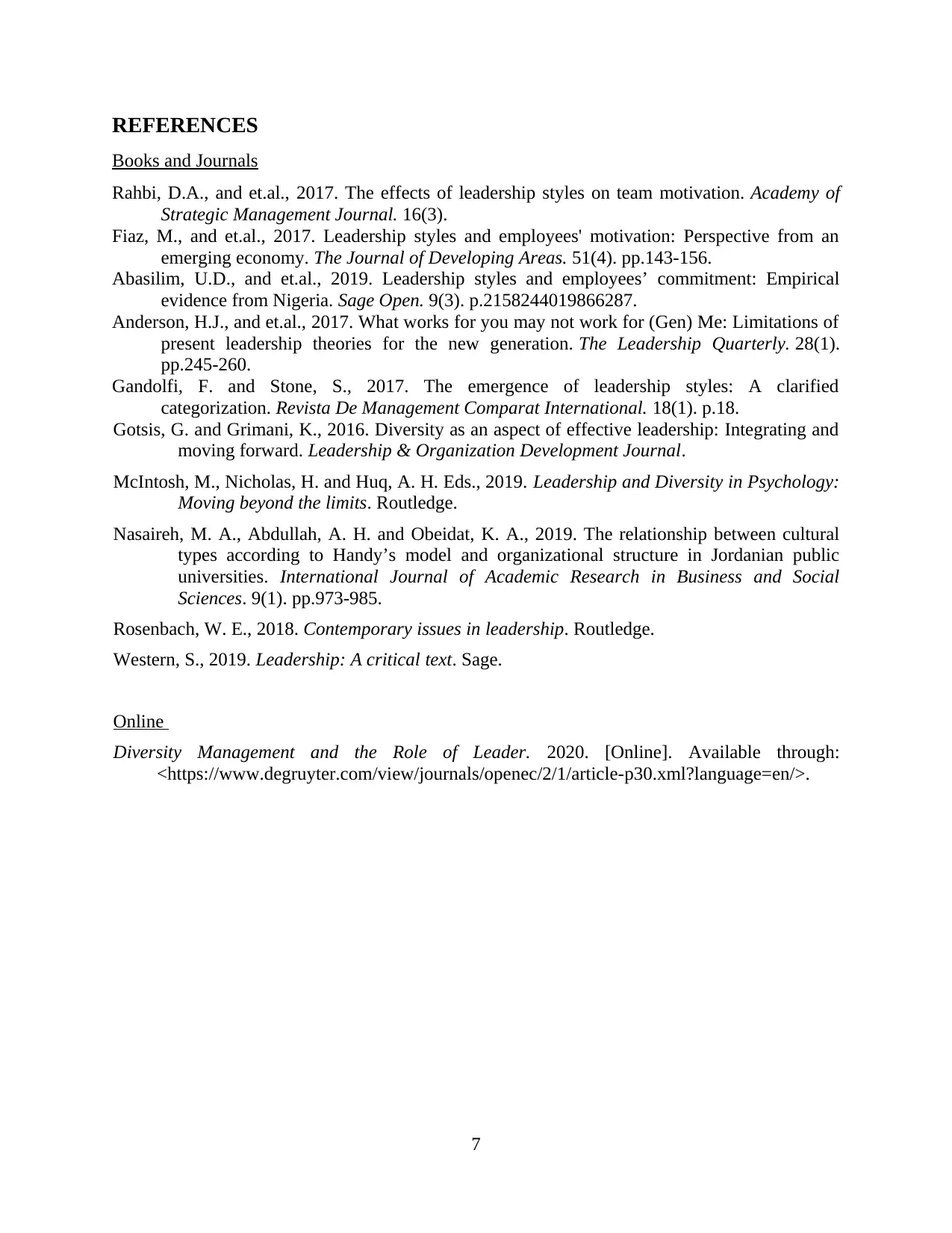
REFERENCES
Books and Journals
Rahbi, D.A., and et.al., 2017. The effects of leadership styles on team motivation. Academy of
Strategic Management Journal. 16(3).
Fiaz, M., and et.al., 2017. Leadership styles and employees' motivation: Perspective from an
emerging economy. The Journal of Developing Areas. 51(4). pp.143-156.
Abasilim, U.D., and et.al., 2019. Leadership styles and employees’ commitment: Empirical
evidence from Nigeria. Sage Open. 9(3). p.2158244019866287.
Anderson, H.J., and et.al., 2017. What works for you may not work for (Gen) Me: Limitations of
present leadership theories for the new generation. The Leadership Quarterly. 28(1).
pp.245-260.
Gandolfi, F. and Stone, S., 2017. The emergence of leadership styles: A clarified
categorization. Revista De Management Comparat International. 18(1). p.18.
Gotsis, G. and Grimani, K., 2016. Diversity as an aspect of effective leadership: Integrating and
moving forward. Leadership & Organization Development Journal.
McIntosh, M., Nicholas, H. and Huq, A. H. Eds., 2019. Leadership and Diversity in Psychology:
Moving beyond the limits. Routledge.
Nasaireh, M. A., Abdullah, A. H. and Obeidat, K. A., 2019. The relationship between cultural
types according to Handy’s model and organizational structure in Jordanian public
universities. International Journal of Academic Research in Business and Social
Sciences. 9(1). pp.973-985.
Rosenbach, W. E., 2018. Contemporary issues in leadership. Routledge.
Western, S., 2019. Leadership: A critical text. Sage.
Online
Diversity Management and the Role of Leader. 2020. [Online]. Available through:
<https://www.degruyter.com/view/journals/openec/2/1/article-p30.xml?language=en/>.
7
Books and Journals
Rahbi, D.A., and et.al., 2017. The effects of leadership styles on team motivation. Academy of
Strategic Management Journal. 16(3).
Fiaz, M., and et.al., 2017. Leadership styles and employees' motivation: Perspective from an
emerging economy. The Journal of Developing Areas. 51(4). pp.143-156.
Abasilim, U.D., and et.al., 2019. Leadership styles and employees’ commitment: Empirical
evidence from Nigeria. Sage Open. 9(3). p.2158244019866287.
Anderson, H.J., and et.al., 2017. What works for you may not work for (Gen) Me: Limitations of
present leadership theories for the new generation. The Leadership Quarterly. 28(1).
pp.245-260.
Gandolfi, F. and Stone, S., 2017. The emergence of leadership styles: A clarified
categorization. Revista De Management Comparat International. 18(1). p.18.
Gotsis, G. and Grimani, K., 2016. Diversity as an aspect of effective leadership: Integrating and
moving forward. Leadership & Organization Development Journal.
McIntosh, M., Nicholas, H. and Huq, A. H. Eds., 2019. Leadership and Diversity in Psychology:
Moving beyond the limits. Routledge.
Nasaireh, M. A., Abdullah, A. H. and Obeidat, K. A., 2019. The relationship between cultural
types according to Handy’s model and organizational structure in Jordanian public
universities. International Journal of Academic Research in Business and Social
Sciences. 9(1). pp.973-985.
Rosenbach, W. E., 2018. Contemporary issues in leadership. Routledge.
Western, S., 2019. Leadership: A critical text. Sage.
Online
Diversity Management and the Role of Leader. 2020. [Online]. Available through:
<https://www.degruyter.com/view/journals/openec/2/1/article-p30.xml?language=en/>.
7
⊘ This is a preview!⊘
Do you want full access?
Subscribe today to unlock all pages.

Trusted by 1+ million students worldwide
1 out of 9
Related Documents
Your All-in-One AI-Powered Toolkit for Academic Success.
+13062052269
info@desklib.com
Available 24*7 on WhatsApp / Email
![[object Object]](/_next/static/media/star-bottom.7253800d.svg)
Unlock your academic potential
Copyright © 2020–2025 A2Z Services. All Rights Reserved. Developed and managed by ZUCOL.



